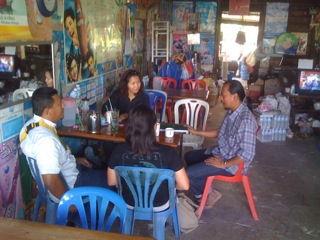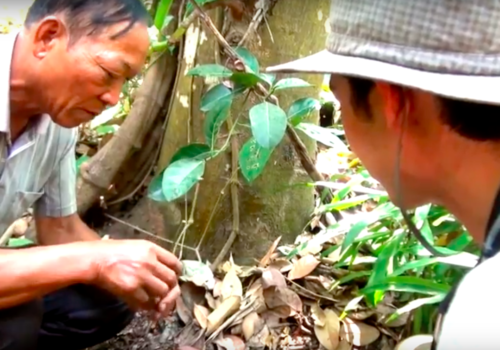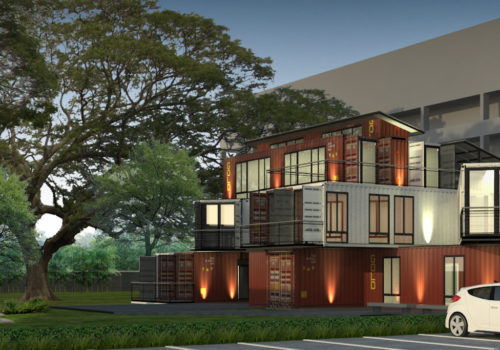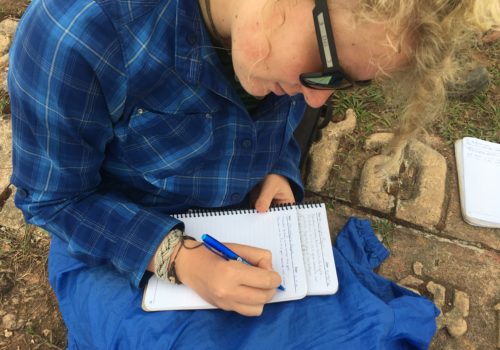To give you an idea of what a recon is like, here is a summary of our 5 day trip to Isaan to work on the Rivers course. (We’ve run this course for 4 years, and are now refining and adding to it, bringing in the Mekong river more.)
Monday Pui, Toto and I (Mark) drove with Pi Yin (who drives for us and helps figure a lot more than just where to go!) to Loei, a trip of about 8 hours, had a late dinner and a long meeting planning out the next few days—finalizing who we needed to talk to after meeting over the last few weeks about the course.

Meeting with Khun Suwit at the wooden noodle shop.
Tuesday we drove to the next province (about 1 1/2 hours) to Udon Thai for a meeting with Khun Suwit, a local activist/NGO contact. We only knew the name of the town and were supposed to meet in a wooden noodle shop across from a school. So, as usual, we got pretty close to where we were going, and started asking people along the road for more specific directions. (We refer to this as “Thai Air Traffic Control”—since once you get close to your destination someone has to talk you into an arrival…) Eventually we got there, and had a great meeting learning about what is happening with rivers in this part of Isaan, how communities are getting organized, and working out some good options for the course. Suwit had a lot of great ideas, and will be helping with making contacts in the villages along the Mekong.
After our meeting, we drove back to Loei province, and then further up to the Mekong river town of Chiang Khan and Pak Chom (the site of a proposed dam across the Mekong). After a short stop in Chiang Khan we followed the road along the Mekong down to Nong Khai, stopping in villages and walking out the the river wherever we could, talking with local people about the river and working out options for teaching sessions. We eventually got into Nong Khai really late, and had dinner (maybe 9 or 10 PM) on the “beach” of the Mekong, where the water has dropped during dry season. (It gets a lot dryer now than in the past, due in part to the Chinese dams upstream.)
Wednesday we continued driving along the border and the Mekong river, stopping to see where we could get down to the river, talking with local people about the how they use the river, what communities are still fishing, etc. We got into Ubon Ratchathani late, met over dinner (at 9 PM) out in a night market set up in a city square to plan the meetings for Thursday. We had a few names, but only one phone number of a village headman in a community where the students had stayed the year before.

Paw in Sabang village showing us his boats and the Mun river.
So Thursday we drove further east about 1 1/2 hours to Nong Bo village, out in the countryside and down a dirt road along the Mun river. We found the headman’s house and met outside under a tree around an old table. The headman was brilliant, with lots of ideas about how to teach the students about the river, village life in Isaan, and why the Mun river is worth fighting for. Then, based on his directons, we headed off to the village of Sabang, further downstream on the Mun and found (again by asking once we got closer) the house of one of the village leaders and activists. She wasn’t home, but her husband was able to take us down to the river, talk about what he would like to teach the students, and discussed other folks in the community who could get involved in teaching. Then, based on his directions, off to the final village we would visit, Hua Heow, to meet Mae (Mother) Charuen.

Talking with Mae Charuen.
Another long drive through dry and dusty country to a hardscrabble village, where we found Mae sitting outside a neighbor’s house. Mae Charuen is a key activist and community educator, and in spite of her years, a very animated and excited (and excitable) person! Once she started chewing betel nut and stuffing huge wads of chaw into her mouth, our ability to understand her Isaan (Lao) dialect dropped dramatically! She has black teeth from years of chewing, and didn’t even need to look as she cut betel and prepped her chaw, all while talking a hundred miles an hour about the river, the importance of it in the community, lots of ideas she had for teaching the Americans why they should love the Mun river too, etc.
We then left the village and drove to the Pak Mun Dam itself, and then headed for a drive to Khon Kaen several hours away. We got there about 8 or 9 PM, and drove around to find a guesthouse, checked in, and looked around for a restaurant for (another) late dinner. We found a great place with a really good band playing Isaan music and “songs for life” (Thai activist / socially engaged songs).
Friday was a long drive back to Chiang Mai, after finding a master instrument builder in Khon Kaen who makes “kaen” and other instruments.
Next, the instructor team sits down to figure out what to do with all our notes, review what we’ve done over the last 4 years, and then we finalize the details over the phone with the folks we’ve been talking with.
In two weeks we go back with the students.



